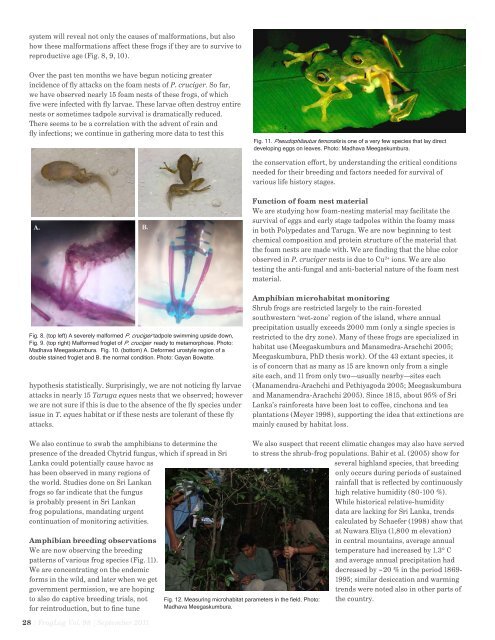download the PDF here - Amphibian Specialist Group
download the PDF here - Amphibian Specialist Group
download the PDF here - Amphibian Specialist Group
You also want an ePaper? Increase the reach of your titles
YUMPU automatically turns print PDFs into web optimized ePapers that Google loves.
system will reveal not only <strong>the</strong> causes of malformations, but also<br />
how <strong>the</strong>se malformations affect <strong>the</strong>se frogs if <strong>the</strong>y are to survive to<br />
reproductive age (Fig. 8, 9, 10).<br />
Over <strong>the</strong> past ten months we have begun noticing greater<br />
incidence of fly attacks on <strong>the</strong> foam nests of P. cruciger. So far,<br />
we have observed nearly 15 foam nests of <strong>the</strong>se frogs, of which<br />
five were infected with fly larvae. These larvae often destroy entire<br />
nests or sometimes tadpole survival is dramatically reduced.<br />
T<strong>here</strong> seems to be a correlation with <strong>the</strong> advent of rain and<br />
fly infections; we continue in ga<strong>the</strong>ring more data to test this<br />
Fig. 11. Pseudophilautus femoralis is one of a very few species that lay direct<br />
developing eggs on leaves. Photo: Madhava Meegaskumbura.<br />
<strong>the</strong> conservation effort, by understanding <strong>the</strong> critical conditions<br />
needed for <strong>the</strong>ir breeding and factors needed for survival of<br />
various life history stages.<br />
Function of foam nest material<br />
We are studying how foam-nesting material may facilitate <strong>the</strong><br />
survival of eggs and early stage tadpoles within <strong>the</strong> foamy mass<br />
in both Polypedates and Taruga. We are now beginning to test<br />
chemical composition and protein structure of <strong>the</strong> material that<br />
<strong>the</strong> foam nests are made with. We are finding that <strong>the</strong> blue color<br />
observed in P. cruciger nests is due to Cu 2+ ions. We are also<br />
testing <strong>the</strong> anti-fungal and anti-bacterial nature of <strong>the</strong> foam nest<br />
material.<br />
Fig. 8. (top left) A severely malformed P. cruciger tadpole swimming upside down,<br />
Fig. 9. (top right) Malformed froglet of P. cruciger ready to metamorphose. Photo:<br />
Madhava Meegaskumbura. Fig. 10. (bottom) A. Deformed urostyle region of a<br />
double stained froglet and B. <strong>the</strong> normal condition. Photo: Gayan Bowatte.<br />
hypo<strong>the</strong>sis statistically. Surprisingly, we are not noticing fly larvae<br />
attacks in nearly 15 Taruga eques nests that we observed; however<br />
we are not sure if this is due to <strong>the</strong> absence of <strong>the</strong> fly species under<br />
issue in T. eques habitat or if <strong>the</strong>se nests are tolerant of <strong>the</strong>se fly<br />
attacks.<br />
<strong>Amphibian</strong> microhabitat monitoring<br />
Shrub frogs are restricted largely to <strong>the</strong> rain-forested<br />
southwestern ‘wet-zone’ region of <strong>the</strong> island, w<strong>here</strong> annual<br />
precipitation usually exceeds 2000 mm (only a single species is<br />
restricted to <strong>the</strong> dry zone). Many of <strong>the</strong>se frogs are specialized in<br />
habitat use (Meegaskumbura and Manamedra-Arachchi 2005;<br />
Meegaskumbura, PhD <strong>the</strong>sis work). Of <strong>the</strong> 43 extant species, it<br />
is of concern that as many as 15 are known only from a single<br />
site each, and 11 from only two—usually nearby—sites each<br />
(Manamendra-Arachchi and Pethiyagoda 2005; Meegaskumbura<br />
and Manamendra-Arachchi 2005). Since 1815, about 95% of Sri<br />
Lanka’s rainforests have been lost to coffee, cinchona and tea<br />
plantations (Meyer 1998), supporting <strong>the</strong> idea that extinctions are<br />
mainly caused by habitat loss.<br />
We also continue to swab <strong>the</strong> amphibians to determine <strong>the</strong><br />
presence of <strong>the</strong> dreaded Chytrid fungus, which if spread in Sri<br />
Lanka could potentially cause havoc as<br />
has been observed in many regions of<br />
<strong>the</strong> world. Studies done on Sri Lankan<br />
frogs so far indicate that <strong>the</strong> fungus<br />
is probably present in Sri Lankan<br />
frog populations, mandating urgent<br />
continuation of monitoring activities.<br />
<strong>Amphibian</strong> breeding observations<br />
We are now observing <strong>the</strong> breeding<br />
patterns of various frog species (Fig. 11).<br />
We are concentrating on <strong>the</strong> endemic<br />
forms in <strong>the</strong> wild, and later when we get<br />
government permission, we are hoping<br />
to also do captive breeding trials, not<br />
for reintroduction, but to fine tune<br />
28 | FrogLog Vol. 98 | September 2011<br />
Fig. 12. Measuring microhabitat parameters in <strong>the</strong> field. Photo:<br />
Madhava Meegaskumbura.<br />
We also suspect that recent climatic changes may also have served<br />
to stress <strong>the</strong> shrub-frog populations. Bahir et al. (2005) show for<br />
several highland species, that breeding<br />
only occurs during periods of sustained<br />
rainfall that is reflected by continuously<br />
high relative humidity (80-100 %).<br />
While historical relative-humidity<br />
data are lacking for Sri Lanka, trends<br />
calculated by Schaefer (1998) show that<br />
at Nuwara Eliya (1,800 m elevation)<br />
in central mountains, average annual<br />
temperature had increased by 1.3° C<br />
and average annual precipitation had<br />
decreased by ~20 % in <strong>the</strong> period 1869-<br />
1995; similar desiccation and warming<br />
trends were noted also in o<strong>the</strong>r parts of<br />
<strong>the</strong> country.
















